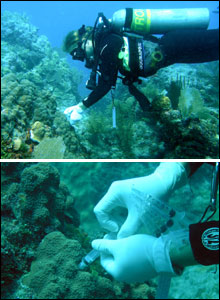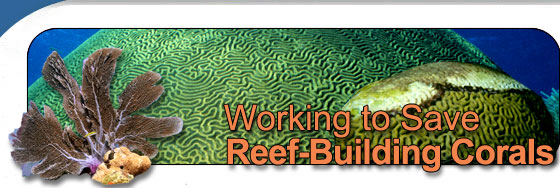Mission Log Sept. 26-27
Kathleen M. Morrow
Auburn University
Dept. of Biological Sciences
 |
|
Figure 1: Aurelia aurita (Moon Jelly) floating along at Pulaski Reef, FL
(Photo: K. Morrow)
|
We are still cruisin’ the western Florida Keys and outer bank reefs. Wednesday afternoon we dove ‘The Pulaski’ – a reef located adjacent to a tower equipped with oceanographic and atmospheric equipment that can monitor the weather as it passes through the western keys into the Gulf of Mexico. The current was ripping, but I got some great photos of moon jellies in the water column with their commensal fish hitchhikers (Figure 1). We spent the evening touring Fort Jefferson until the rain forced us back to the ship. There are some idyllic views that span 360o from the upper battlements.
Today (Thursday) we descended about 75 feet onto deeper reefs in the Tortugas Banks. There was an ominous darkness that enveloped us as we sunk deeper through the water column – this is because red and yellow wavelengths can not travel as deep as the blue and green spectrum. As we settled down to the bottom we could immediately recognize a difference in benthic diversity compared with the shallow reefs we surveyed over the past few days. Here there were far fewer gorgonians (e.g. sea fans) and soft corals. There also were several coral species that were more common at this deeper depth (e.g. Montastrea franksi, Mycetophyllia sp. and Dendrogyra).
 |
|
Figure 2: Kathy Morrow sampling Montastrea coral microbial communities (A). Small plastic-tipped syringes were used to collect coral mucus with associated microorganisms (B). (Photo: K. Grimshaw)
|
Though I was most intrigued by the macroalgal differences – at depth there were very few Halimeda, a calcareous green alga. Halimeda are generally a primary component of shallow reef communities and contribute a significant portion of calcium carbonate which is then incorporated back into the ecosystem. These deeper reefs were dominated by several species of Dictyota, which are fleshy brown algae (also prevalently found on shallow reefs), but thrown into the mix were short bushy clumps of Hypnea and encrusting Lobophora.
 |
|
Figure 3: Kathy Morrow just hanging out on the survey line (Photo: J.Voss)
|
As a Ph.D student at Auburn University my research interests generally include how these foliose macroalgae associate with one another and with corals through competitive and facilitative interactions. Unfortunately, algal abundance continues to escalate on present-day reef causing a correlative increase in their contact rate with corals. I’m interested in how interactions between corals and algae might change the microflora that reside on a coral surface. Organisms, such as humans, have natural microbial communities that serve to protect us from disease and assist in boosting our immune system. Because corals do not have complex immune systems, microbes are proving to be a critical protective mechanism against disease. When these bacteria are disrupted, the overall health of the coral may be compromised leading to an increase in disease susceptibility. During the cruise, I will collect samples of microorganisms from coral mucus and associated algae using small plastic tipped syringes (Figure 2). Later molecular analysis of these data will help identify which microbes are present and whether the increasing abundance of algae plays a role in the prevalence of coral disease along the Florida Keys reef tract.
The NOAA coral health and disease cruise has been a tremendous experience. I feel collaboration among fellow scientists in multiple disciplines is critical to understanding how ecosystems function. I think all would agree that the atmosphere aboard the NOAA ship Nancy Foster was dynamic and supportive toward integrating and expanding our knowledge of these beautiful ecosystems, as well toward making some lasting friendships!
|



